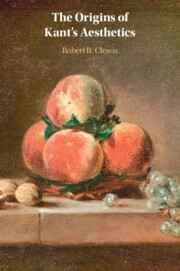107 results
Demand for fish in Great Britain is driven by household income and taste
-
- Journal:
- Public Health Nutrition / Accepted manuscript
- Published online by Cambridge University Press:
- 19 March 2025, pp. 1-30
-
- Article
-
- You have access
- Open access
- Export citation
“History in a Wine Glass” - Race, Taste and the Grape: South African Wine from a Global Perspective Paul Nugent. Cambridge: Cambridge University Press, 2024. Pp. 374. $130.00, hardcover (ISBN: 978100918426); $130.00, ebook (ISBN: 9781009204040).
-
- Journal:
- The Journal of African History , First View
- Published online by Cambridge University Press:
- 19 February 2025, pp. 1-2
-
- Article
- Export citation
Topographies of Fungibility: Reinventing the Japanese Taste for Sweetness in the Philippine Highlands
-
- Journal:
- Comparative Studies in Society and History / Volume 67 / Issue 2 / April 2025
- Published online by Cambridge University Press:
- 10 January 2025, pp. 377-403
-
- Article
-
- You have access
- Open access
- HTML
- Export citation

Evolutionary Aestheticism in Victorian Culture
-
- Published online:
- 05 December 2024
- Print publication:
- 12 December 2024
Chapter 4 - Aesthetic Agents
-
- Book:
- Guru Nanak's Transcendent Aesthetics
- Published online:
- 21 November 2024
- Print publication:
- 21 November 2024, pp 161-204
-
- Chapter
- Export citation
Chapter 7 - Taste and See
- from Part II - Myth and Culture
-
- Book:
- Theology and the Mythic Sensibility
- Published online:
- 07 November 2024
- Print publication:
- 21 November 2024, pp 131-152
-
- Chapter
- Export citation
10 - ‘Leading Strings’
- from Part III - Clare’s Image
-
-
- Book:
- The Cambridge Companion to John Clare
- Published online:
- 14 November 2024
- Print publication:
- 21 November 2024, pp 151-165
-
- Chapter
- Export citation
4 - Looking for God
-
- Book:
- The Theological Imagination
- Published online:
- 09 November 2024
- Print publication:
- 07 November 2024, pp 105-126
-
- Chapter
- Export citation
Feeling the rules: Historical and contemporary perspectives on emotional norms and social distinction
-
- Journal:
- Social Science History / Volume 48 / Issue 4 / Winter 2024
- Published online by Cambridge University Press:
- 11 December 2024, pp. 603-619
- Print publication:
- Winter 2024
-
- Article
-
- You have access
- Open access
- HTML
- Export citation
17 - Food and the Essay
- from Part II - The Great Age of the British Essay
-
-
- Book:
- The Cambridge History of the British Essay
- Published online:
- 31 October 2024
- Print publication:
- 04 July 2024, pp 246-259
-
- Chapter
- Export citation
Alterations to sour taste intensity in depression
-
- Journal:
- Proceedings of the Nutrition Society / Volume 83 / Issue OCE1 / April 2024
- Published online by Cambridge University Press:
- 07 May 2024, E143
-
- Article
-
- You have access
- Export citation
8 - Ecce Mann
-
-
- Book:
- Nietzsche and Literary Studies
- Published online:
- 03 May 2024
- Print publication:
- 25 April 2024, pp 186-209
-
- Chapter
- Export citation
2 - The Young Englishman
- from Part I - Growing up English
-
- Book:
- Lucky Valley
- Published online:
- 11 January 2024
- Print publication:
- 22 February 2024, pp 65-84
-
- Chapter
- Export citation

The Origins of Kant's Aesthetics
-
- Published online:
- 10 January 2024
- Print publication:
- 26 January 2023
Kant on Free Speech: Criticism, Enlightenment, and the Exercise of Judgement in the Public Sphere
-
- Journal:
- Kantian Review / Volume 29 / Issue 1 / March 2024
- Published online by Cambridge University Press:
- 15 December 2023, pp. 61-80
- Print publication:
- March 2024
-
- Article
-
- You have access
- Open access
- HTML
- Export citation
Living Freedom: The Heautonomy of the Judgement of Taste
-
- Journal:
- Kantian Review / Volume 29 / Issue 1 / March 2024
- Published online by Cambridge University Press:
- 13 December 2023, pp. 81-102
- Print publication:
- March 2024
-
- Article
-
- You have access
- HTML
- Export citation
Chapter 6 - A Slave Named Voltaire; or, Gender and the Making of American Taste
- from Part II - Creating Enlightened Citizens
-
- Book:
- A Caribbean Enlightenment
- Published online:
- 14 September 2023
- Print publication:
- 05 October 2023, pp 143-161
-
- Chapter
- Export citation
Chapter 2 - Collecting Ballads, Historicizing Sounds
-
-
- Book:
- Sound and Sense in British Romanticism
- Published online:
- 24 August 2023
- Print publication:
- 07 September 2023, pp 39-59
-
- Chapter
-
- You have access
- Open access
- HTML
- Export citation
Chapter 1 - Bad Taste
-
- Book:
- Edible Arrangements
- Published online:
- 26 September 2023
- Print publication:
- 31 August 2023, pp 22-59
-
- Chapter
- Export citation
5 - Modernism and the Middlebrow
- from Part I - Methodologies
-
-
- Book:
- The Cambridge History of American Modernism
- Published online:
- 13 July 2023
- Print publication:
- 20 July 2023, pp 98-112
-
- Chapter
- Export citation


